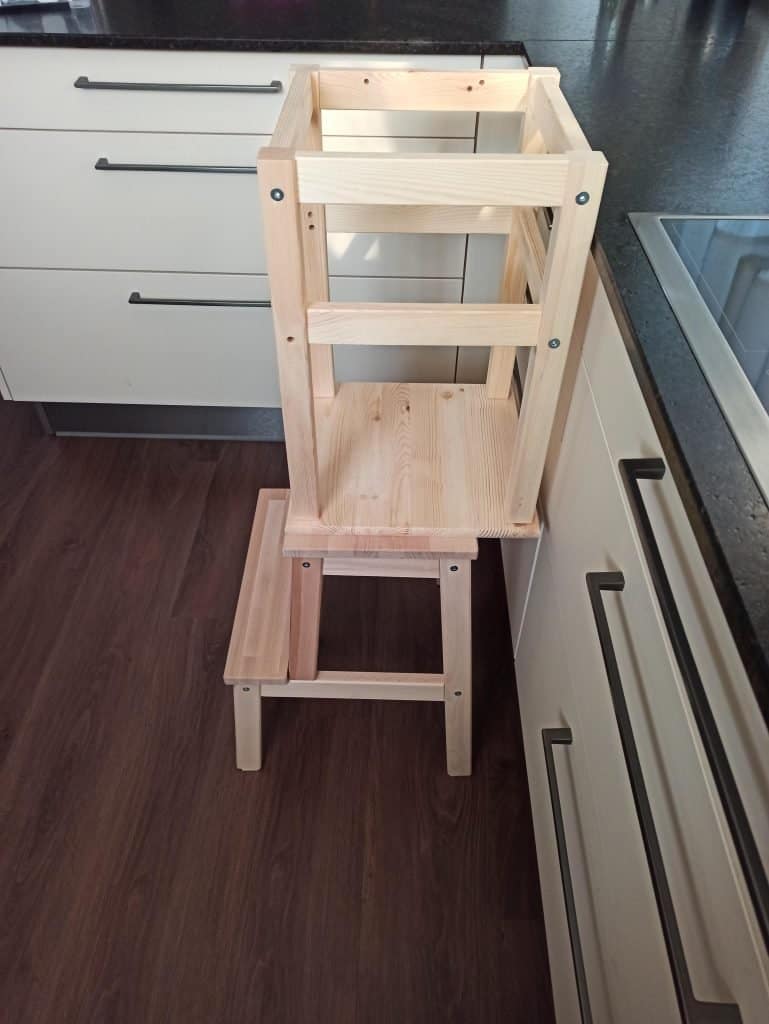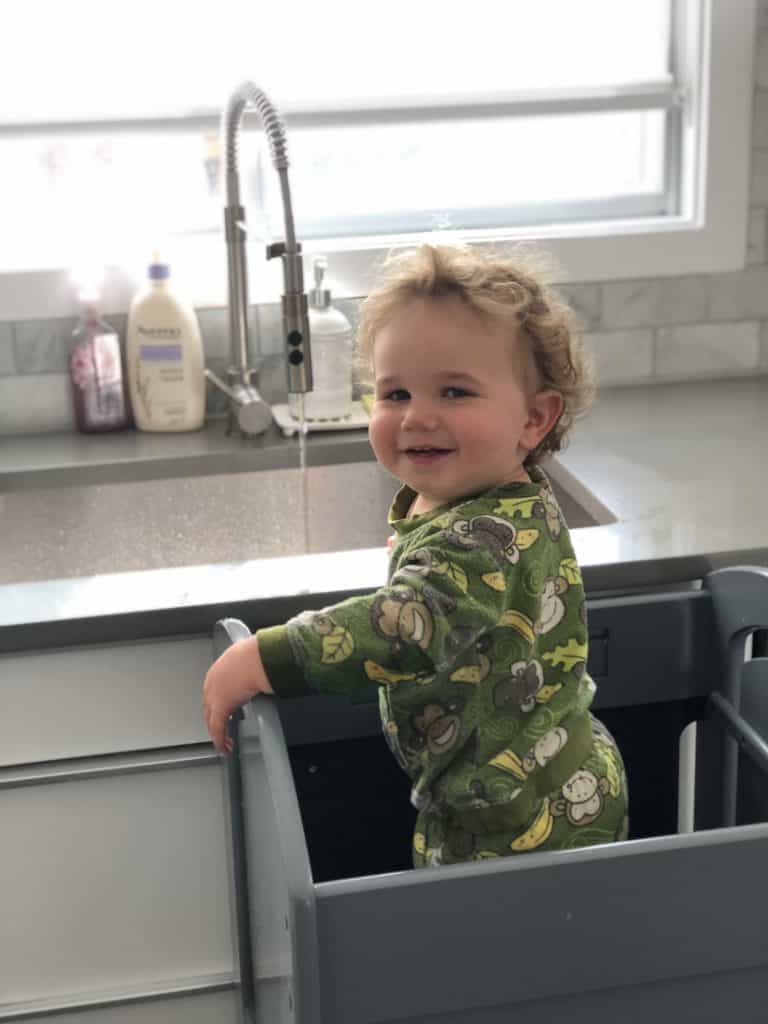Much of the ideology behind the Montessori Method lies in the concept that children learn by doing and exploring. This is shown in the way that Montessori toys and materials are functional and grounded in reality.
A Montessori tower – sometimes called a learning tower or kitchen helper – is a great tool that allows your child to safely participate in family activities, like cooking and cleaning, that foster real-life skills and experiences.
Typically, a toddler can start using a learning tower at around 2 years old. In some cases, kids can start as early as 18 months if they are ready and have met certain basic milestones. Montessori towers help develop independence in a toddler, as they are able to observe and then engage in activities that are routine parts of daily life.
This may include everything from observing and assisting in the preparation of meals, washing dishes, even brushing teeth or helping with household projects!
In this article, we will explore how a learning tower can become a great addition to any home.

What is a learning tower?
Simply put, a learning tower is a type of step stool, but with added safety features meant to allow toddlers and young preschoolers participate in kitchen tasks. A typical toddler learning tower is a raised platform or step stool with safety rails or walls around the top step.
The wide base and safety rails allow for a toddler to stand at countertop height with minimal supervision and interference from parents.
Everyday step stools are not adjustable, which means that if you decide to place your toddler on one, you need to choose whether to somehow modify the stool height or have your child stand on a chair in order to allow the child to reach the counter.
With either option, your toddler must either hold onto the counter or a parent, making it impossible to fully participate in cooking, cleaning, or whatever activity is happening.
A Montessori tower, on the other hand, has several features that make it flexible and safe, and allows both the child and the parent to fully engage in the kitchen task at hand.
These are some common features of learning towers:
- A type of step or ladder that allows the child to climb into the learning tower himself
- Guard rails on sides to prevent falls (some learning towers may have three rails with one open side, others may have rails on all four sides). Some models even have four full walls
- A wide base that allows for movement while the child is standing in the learning tower with toes-kicks so the foot won’t slip out
- On some types of learning towers, a platform that can be height adjusted as the child grows
Learning towers are sturdy and made from quality wood, although some versions available on the market may be made of plastic. They come in a variety of price ranges and sizes, which makes it easy to find a Montessori tower that will work for your family’s needs.
When are toddlers ready to start using a learning tower?
Learning towers are recommended for children starting at the age of 18 months going all the way up to 6 years old. A learning tower’s recommended age range may vary from product to product, depending on how much the learning tower’s height can be adjusted as well as the safety features.
In order to safely use a Montessori tower or kitchen helper, your child should meet certain developmental milestones.
If your child is able to stand steadily on his own, he is probably ready for a learning tower, even if he is not ready to climb into the tower independently yet.
An age-appropriate attention span, at least five minutes of independent engagement, is also important. These milestones will vary widely from child to child, and you will have to evaluate your own child’s readiness.

What to look for in a starter learning tower
There are several things you will want to look for when deciding on a learning tower for your toddler. As with any product for your child, there is no one-size-fits-all option, and it is worth the time to research all the available learning tower options before making a purchase.
I also put together a comprehensive guide of the best learning towers that you can read for more ideas and tips.
Adjustable Height
You want a learning tower that will grow with your child. Depending on the age and size of your child at the time of purchase, you may want a Montessori tower that allows you to easily adjust the platform to multiple levels. When your child stands inside the learning tower, the top of the tower should be somewhere between his armpits and belly button.
Safety
A quality Montessori tower will have sturdy construction out of quality materials, and should meet safety standards for a toddler kitchen stool. You may also wish to invest in a learning tower that has some sort of non slip surface on the platform, to prevent falls.
Speaking of preventing falls, the design of the learning tower should be taken into account. Some styles of learning towers have rails or some other solid barrier on all sides (if a solid barrier is used, there is typically one side left open with a rail across the top of that side for safety).
Other styles may have only three sides enclosed in some way. The type you choose depends on what will be safest for your child’s age and development.
Maneuverability, Size, and Storage
The construction of a learning tower in terms of material and design will impact its weight. If you have one set place where you will almost always be using the learning tower, weight may not be a deciding factor. However, if you plan to move the learning tower around your kitchen or even other parts of your house, you may want a lighter model that is easy to move from place to place.
Size and storage are additional factors you should consider. Depending on the brand and style, learning towers may have very large footprints. If space is at a premium in your kitchen or you need to be able to store it between uses, you may want a learning tower that is smaller in size.
Some learning towers also fold in some manner, which can make storage much easier.
Functionality and Flexibility
When choosing a learning tower, you may need to consider how functional and flexible it will be for your family. Some learning tower models may have removeable pieces that allow for older, more independent children to use the tower, while others can convert to chairs or small tables.
Flexibility may also be important in terms of how many children will use the tower. If you have multiple children of different ages, a learning tower that can be easily adjusted for use by different children may be beneficial.
Price
Your family’s budget should be a consideration when buying a learning tower. The cost of a learning tower depends on the materials used in construction, its size, its level of adjustability or other features, and, in some cases, the brand. Learning towers can range in price from about $80 to over $250.
Knowing your budget needs will help you make a decision about which learning tower to buy.
Check out my review of the Little Partners Learning Tower, my favorite learning tower.
Best learning tower activities for Kids Starting to Use a Learning Tower
Regardless of which Montessori tower you choose for your family, there are many activities that will be perfect matches across a wide age-range. The following examples are just the tip of the iceberg when it comes to activities that you can do with your child, when they are starting to use a learning tower.
Ages 18 Months to 2 Years
- Practice climbing up and down steps/short ladders
- Practice washing hands with an adult’s help
- Observing during the preparation of meals
- Playing with small toys on the counter while parents watch and work in the kitchen
Ages 2 to 3 Years
- Helping with food preparation, such as washing fruits and vegetables at the sink
- Helping to wash dishes, even if just rinsing
- Brushing teeth with an adult’s help
- Getting items from high drawers and cupboards
Ages 3 to 5 Years
- Food preparation tasks like measuring and stirring
- Pouring foods like cereal
- Serving assembled foods that have already been prepared
- Rolling and cutting cookie or pie dough
Find more learning tower activities for toddler here.
Final Thoughts
Montessori learning towers allow your child to engage in household tasks and learn independent skills from a very young age. Instead of being stuck in a high chair or playpen across the room, your child can be right beside you in the kitchen, learning from you about how to cook, clean, and care for his personal hygiene.
With so many different learning towers available at many different price points, there is sure to be a learning tower out there that is right for you and your child.
Vikki is the creator of Totsgo and the mother of two children. She is a passionate mother who enjoys assisting other parents.
